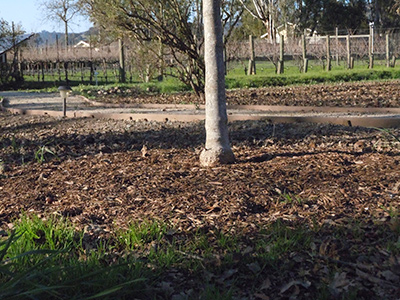The subject of amendments got prominent attention in an important 1975 paper—The Effects of Soil Amendments and Fertilizer Levels on the Establishment of Silver Maples. This study found that the poorest growth was observed on trees grown in soils amended with pine bark. At 40% bark-amended soil, a majority of trees were dead by mid-winter—turns out that pine bark depletes nitrogen. Their conclusion? “These data do not support the use of soil amendments in the establishment and growth of newly planted trees.”
• In a Minnesota Study, it was found that the addition of vermiculite or sawdust to peat resulted in no better growth of landscape.
• A Southern California study of five species of palm trees found that there was no benefit when using an amendment of a composted, nitrogen-stabilized Douglas fir shavings (10)
• The prestigious Arbor Day Foundation advised, in the 2013 pamphlet “How to Plant Balled and Burlapped Trees:” “Use the original soil (italics mine) around the root ball and be sure there aren't any air pockets.”

Compost
So what about the currently most popular organic amendment, compost, the use of which is espoused by some to an almost fanatic level? The results are mixed.
One of the horticulturists I really respect is Dr. Gary Watson (head of research at the prestigious Morton Arboretum in Lisle, IL). Along with three cohorts, he studied three planting holes filled with:
- Un-amended clayey site-soil that had been removed from the holes
- Site-soil amended with 2 mm sand and composted organic matter (50%, 40%, 10% by volume)
- Medium-textured loam topsoil.
As I would have expected, they found there was little incentive to amend the soil. All the amendments produced no increase in the trees’ trunk diameter.
Edward Gilman, Professor, of Urban Trees & Landscape Plants at the University of Florida Environmental Horticulture Dept., is another plant scientist whose work I’ve read and valued for over 20 years. He did a two-year study on soil amendments (important because so few studies have been extended past the first year). This longer study time allows the researchers to observe trees well past any possible effect on growth of amendments used in their planting holes. He found that composted yard waste did not enhance growth over that of control trees with no amendments.
Amending the Soil, not the Hole
Using compost as a soil amendment on a wide area outside of the planting hole is a “hole” different story. Three to four inches of compost added to the top seven inches of sandy soil was found to increase root mass in a study done over a 12-month period, although the overall shoot growth (the branches above ground) was pretty much the same as that of the unamended plants. Researchers used lime-stabilized sewage sludge with composted poultry manure, and slow-release nitrogen fertilizer (Scott’s Osmocote) over an area outside the planting hole and found a higher levels of biomass, organic matter and nitrogen levels.
Another two-year experiment found that the root systems “may strongly” benefit from the addition of organic fertilizers outside of the planting area. Although fruit production and trunk growth may not show any benefits, the roots do. Compost added outside of the planting hole was found to increase the production of new roots compared with the other treatments, and the root lifespan was longer in compost-treated trees than in those amended with mineral fertilizers.
Amendments and Moisture
One drawback to the use of amendments in the planting hole is summed up by Dr. Linda Chalker-Scott, Extension Horticulturist and Associate Professor at the Puyallup Research and Extension Center of the Washington State University:
“Soil water movement is problematic ... amended backfill has markedly different characteristics than surrounding native soil; it is more porous and water will wick away to the finer-textured native soil. In the summer, moisture within the planting hole will be depleted by the plant but not replaced by water held more tightly in the native soil.
This results in water stress to the plant unless the planting hole is kept irrigated, a costly and often unrealistic practice. During wet seasons water will move quickly through the amended soil only to be held back by the more slowly draining native soil. The resulting bathtub effect, wherein water accumulates in the planting hole, floods the roots and eventually kills the plant. Finally, all organic material eventually decomposes. If you've incorporated one quarter or one half organic matter by volume, within a few years you will have a sunken garden in your landscape. This only exacerbates the flooding problem during wet conditions.” (See Chalker-Scott’s web site for more: http://puyallup.wsu.edu/~linda%20chalker-scott/)
In short, no scientific studies to date show any measurable benefit of soil amendment except in containerized plant production. Plants grown in native soil consistently showed better root establishment and more vigorous growth. One study reported no negative effects of amending soil with organic matter—but there were no benefits, either. When you consider the cost of materials and labor needed to incorporate soil amendments, it's difficult to justify the practice.
This outdated practice (using amendments in the planting hole) is, however, still required in the specifications of architects, landscapers and other groups associated with landscape installation. It is still recommended by garden centers and gardening articles. And there is a multi-million-dollar soil-amendment industry that has little interest in debunking this myth. All responsible green industry professionals need to recognize and avoid these kinds of proven-to-be-non-sustainable management practices. |

